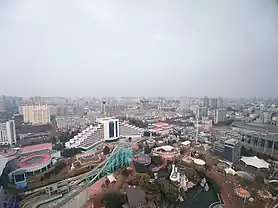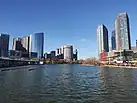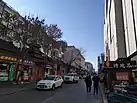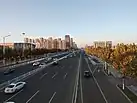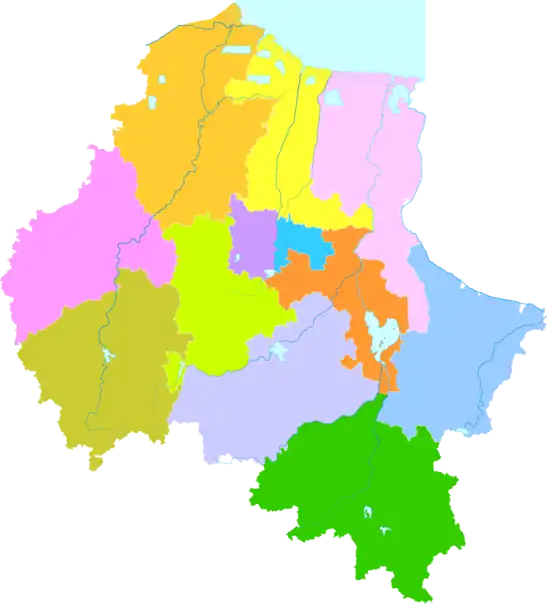Weifang
Weifang (simplified Chinese: 潍坊; traditional Chinese: 濰坊; pinyin: Wéifāng) is a prefecture-level city in central Shandong province, People's Republic of China. The city borders Dongying to the northwest, Zibo to the west, Linyi to the southwest, Rizhao to the south, Qingdao to the east, and looks out to the Laizhou Bay to the north. Its population was 9,386,705 at the 2020 census, of whom 3,095,520 lived in the built-up (or metro) area made up of four urban districts (Kuiwen, Weicheng, Hanting and Fangzi) and Changle County largely being urbanized.
Weifang
潍坊市 | |
|---|---|
Left to right, top to bottom: Skyline viewed from the Fuwah Park Ferris Wheel, the Bailang River, Kuiwenmen Street, Weifang Middle Road with Weifang University visible to the left, Weifang Grand Theater | |
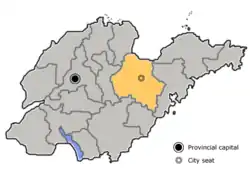 Location of Weifang City jurisdiction in Shandong | |
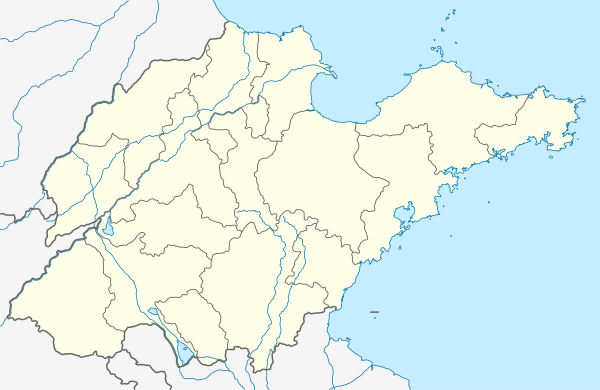 Weifang Location in China  Weifang Weifang (China) | |
| Coordinates (Weifang municipal government): 36°42′29″N 119°09′43″E | |
| Country | People's Republic of China |
| Province | Shandong |
| Municipal seat | Kuiwen District |
| Subdivisions | |
| Government | |
| • Party Secretary | Liu Yun |
| • Mayor | Liu Jianjun |
| Area | |
| • Prefecture-level city | 16,143.14 km2 (6,232.90 sq mi) |
| • Urban | 2,646.1 km2 (1,021.7 sq mi) |
| • Metro | 3,746.6 km2 (1,446.6 sq mi) |
| Elevation | 32 m (106 ft) |
| Population (2020 census)[1] | |
| • Prefecture-level city | 9,386,705 |
| • Density | 580/km2 (1,500/sq mi) |
| • Urban | 2,511,721 |
| • Urban density | 950/km2 (2,500/sq mi) |
| • Metro | 3,095,520 |
| • Metro density | 830/km2 (2,100/sq mi) |
| • Major nationalities | Han Chinese |
| Time zone | UTC+8 (China Standard) |
| Postal code | 261000 (Urban center) 261300, 261500, 262100, 262200, 262400-262700 (Other areas) |
| Area code | 536 |
| ISO 3166 code | CN-SD-07 |
| License plate prefixes | 鲁G & 鲁V |
| GDP | CNY 478.67 billion (2014) |
| Coastline | 113 kilometres (70 mi) |
| Website | http://www.weifang.gov.cn/ |
Weifang has numerous natural and historic sites, such as Shihu Garden (from the Late Ming and early Qing Dynasty), Fangong Pavilion (from the Song Dynasty), fossil sites (including dinosaur fossils, in Shanwang, Linqu), Mount Yi National Forest Park, Mount Qingyun and the Old Dragon Spring. Painted New Year woodcuts from Yangjiabu are also well known. The city is served by Weifang Airport to various cities across China.
Administration
The prefecture-level city of Weifang administers 12 county-level divisions, including four districts, six county-level cities and two counties.Weifang City governs 4 districts: Kuiwen, Weicheng, Hanting, and Fangzi; 6 county-level cities: Qingzhou, Zhucheng, Shouguang, Anqiu, Gaomi, and Changyi; and 2 counties: Linqu and Changle. County-level cities are at the same level as counties, so there are 12 districts and counties. In addition, there are 59 streets and 59 towns in the city. The residents are mainly Han, with 50 ethnic minorities including Hui and Manchu.
| Map | ||
|---|---|---|
| Subdivision | Chinese | Pinyin |
| Weicheng District | 潍城区 | Wéichéng Qū |
| Hanting District | 寒亭区 | Hántíng Qū |
| Fangzi District | 坊子区 | Fāngzǐ Qū |
| Kuiwen District | 奎文区 | Kuǐwén Qū |
| Linqu County | 临朐县 | Línqú Xiàn |
| Changle County | 昌乐县 | Chānglè Xiàn |
| Qingzhou | 青州市 | Qīngzhōu Shì |
| Zhucheng | 诸城市 | Zhūchéng Shì |
| Shouguang | 寿光市 | Shòuguāng Shì |
| Anqiu | 安丘市 | Ānqiū Shì |
| Gaomi | 高密市 | Gāomì Shì |
| Changyi | 昌邑市 | Chāngyì Shì |
Geography and climate
Nearby major cities include Jinan and Zibo to the west, Yantai to the northeast and Qingdao to the southeast.
Weifang has a monsoon-influenced, four-season humid continental climate (Köppen Dwa), with hot, humid summers, and cold but dry winters. Monthly daily average temperatures range from −2.8 °C (27.0 °F) in January to 26.3 °C (79.3 °F) in July, and the annual mean is 12.71 °C (54.9 °F). More than 70% of the annual precipitation occurs from June to September, and sunshine is generally abundant year-round. A majority of the annual precipitation occurs in July and August alone. With monthly percent possible sunshine ranging from 47% in July to 62% in April, the city receives 2,536 hours of bright sunshine annually, sunshine is abundant except during the summer months.
| Climate data for Weifang (1991–2020 normals, extremes 1971–2010) | |||||||||||||
|---|---|---|---|---|---|---|---|---|---|---|---|---|---|
| Month | Jan | Feb | Mar | Apr | May | Jun | Jul | Aug | Sep | Oct | Nov | Dec | Year |
| Record high °C (°F) | 17.6 (63.7) |
24.2 (75.6) |
31.5 (88.7) |
34.9 (94.8) |
40.7 (105.3) |
41.4 (106.5) |
39.5 (103.1) |
37.3 (99.1) |
39.0 (102.2) |
35.8 (96.4) |
26.3 (79.3) |
22.6 (72.7) |
41.4 (106.5) |
| Average high °C (°F) | 3.5 (38.3) |
7.1 (44.8) |
13.6 (56.5) |
20.4 (68.7) |
26.1 (79.0) |
30.3 (86.5) |
31.6 (88.9) |
30.4 (86.7) |
27.0 (80.6) |
21.1 (70.0) |
12.8 (55.0) |
5.7 (42.3) |
19.1 (66.4) |
| Daily mean °C (°F) | −2.3 (27.9) |
0.8 (33.4) |
6.7 (44.1) |
13.6 (56.5) |
19.6 (67.3) |
24.1 (75.4) |
26.7 (80.1) |
25.6 (78.1) |
21.2 (70.2) |
14.7 (58.5) |
6.8 (44.2) |
0.0 (32.0) |
13.1 (55.6) |
| Average low °C (°F) | −6.6 (20.1) |
−4.2 (24.4) |
1.0 (33.8) |
7.4 (45.3) |
13.4 (56.1) |
18.6 (65.5) |
22.5 (72.5) |
21.7 (71.1) |
16.2 (61.2) |
9.5 (49.1) |
2.0 (35.6) |
−4.2 (24.4) |
8.1 (46.6) |
| Record low °C (°F) | −17.2 (1.0) |
−17.9 (−0.2) |
−11.6 (11.1) |
−6.8 (19.8) |
0.9 (33.6) |
6.3 (43.3) |
12.9 (55.2) |
13.0 (55.4) |
4.0 (39.2) |
−4.3 (24.3) |
−11.7 (10.9) |
−16.5 (2.3) |
−17.9 (−0.2) |
| Average precipitation mm (inches) | 6.4 (0.25) |
12.7 (0.50) |
12.8 (0.50) |
27.9 (1.10) |
48.7 (1.92) |
76.9 (3.03) |
131.1 (5.16) |
160.0 (6.30) |
52.9 (2.08) |
28.1 (1.11) |
26.6 (1.05) |
10.3 (0.41) |
594.4 (23.41) |
| Average precipitation days (≥ 0.1 mm) | 2.9 | 3.2 | 3.3 | 5.3 | 6.6 | 7.7 | 11.4 | 11.5 | 6.0 | 5.2 | 4.6 | 3.9 | 71.6 |
| Average snowy days | 3.8 | 3.5 | 1.3 | 0.1 | 0 | 0 | 0 | 0 | 0 | 0 | 0.8 | 2.7 | 12.2 |
| Average relative humidity (%) | 64 | 61 | 56 | 58 | 62 | 66 | 77 | 80 | 73 | 68 | 67 | 64 | 66 |
| Mean monthly sunshine hours | 166.1 | 167.9 | 218.0 | 234.6 | 258.7 | 224.9 | 192.2 | 193.5 | 202.7 | 197.5 | 165.6 | 165.6 | 2,387.3 |
| Percent possible sunshine | 54 | 55 | 58 | 59 | 59 | 51 | 43 | 47 | 55 | 57 | 55 | 55 | 54 |
| Source: China Meteorological Administration[2][3][4] | |||||||||||||
Economy
The city is home to the large diesel engine company and factory Weichai, and Shengrui Transmission manufacturer.[5] The village of Yangjiabu in Hanting District is famous for folk wood-block print (nianhua) and kite production.
In the 1980s, many sapphire deposits were discovered in Changle County. According to released information, billions of carats of sapphire are estimated to lie under an area of 450 km2 (170 sq mi). Mining here has become one of the top four sapphire producers in the world. The main feature of this sapphire is the dark blue or close to black color because of the high iron content.
Established in August 1995, the Weifang Binhai Economic & Technological Development Area (BEDA) is a national economic and technological development area approved by the State Council. Covering an area of 677 km2 (261 sq mi), BEDA has a population of 100,000. BEDA possesses a large state-owned industrial land for use with an area of 400 km2 (150 sq mi). BEDA has been accredited as a National Demonstration Zone invigorating the Sea by Science and Technology, National Innovation Base for Rejuvenating Trade through Science and Technology and National Demonstration Eco-Industry Park.
Weifang is an important economic center of Shandong Province, with numerous shopping centers. Fangzi Taihua City, located in Fangzi District, Weifang City, was built by Shandong Century Taihua Group with a construction area of about 130,000 square meters and equipped with 1,200 parking spaces. It officially opened on September 17, 2021.
Military
Weifang is the headquarters of the 26th Group Army of the People's Liberation Army, one of the three group armies that comprise the Jinan Military Region responsible for defense of the Yellow River Plain.
History
Weifang has a long history. According to archaeological discoveries, there are more than 1,800 ancient cultural sites in different times in China. Among them, the first Beixin cultural relic in eastern Shandong was found in taoyuan village, Qingzhou; The ancient castle site of Longshan culture excavated by Shouguang Bianxian Wang is rare in China. The typical Longshan cultural site in Yaoguanzhuang, Weicheng District is rich in unearthed relics, far exceeding the excavation of Chengziya site before liberation.
This shows that as early as 7000 years ago, our ancestors lived here. In Xia and Shang dynasties, there were such countries as pouring irrigation, pouring bamboo, cold and three longevity. At the beginning of the Zhou Dynasty, King Wu sealed the state and founded the country, and made Tai Gong Wang Yu Qi and Du Yingqiu (now in Changle). To the Spring and Autumn Period, the present municipal districts once belonged to Qi, Lu, Qi, Ju and other countries. During the Warring States period, most of the current ministries were in harmony, and Wulian and Zhucheng belonged to Shandong.
As early as the Neolithic Age, there were ancestors living next to the old roads of Weihe River and Mihe River in Weifang. The ancient tribal people living here are called "Dongyi people". They have created a rich and colorful Dongyi culture, which is one of the sources of Chinese civilization.
During the Eastern Zhou Dynasty, Weifang belonged to the same land, bordering the Bohai Sea in the north, and it had the advantage of "fish and salt". Counties were established in Qin Dynasty, and most of Weifang belonged to Jiaodong County, Qi County and Langya County. In the fifth year of Emperor Yuan Feng of the Han Dynasty (106 BC), Qingzhou Secretariat Department was established, which was located in Guang County (located in Qingzhou today). During the Sixteen Kingdoms Period of the Eastern Jin Dynasty, Murong De, a Xianbei people, established the Southern Yan regime, whose capital was located in Guanggu City (now Qingzhou City, Weifang), and in the 16th year of Emperor Kai of Sui Dynasty (596), it was located in Weizhou.
During this period, as one of the earliest areas where Buddhism was introduced into the Han Dynasty, Weifang became the center of Buddhism in Qilu, leaving a large number of Buddhist cultural relics, such as the hoard of Buddhist statues in longxing temple, Qingzhou and Tuoshan, and the statues in Yunmen Mountain and Shimenfang Grottoes.
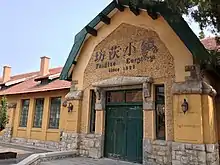
Culture
Kite flying
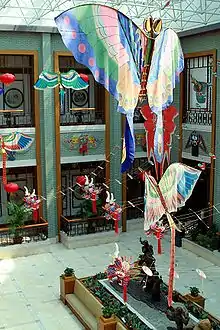
Kite flying is a traditional custom among the people in Weifang in spring time. In 1984, the first international kite festival was held in Weifang. More than ten thousand kite fans attended the opening ceremony. People from eleven countries and regions, including the United States and Canada, took part in the festival, flying kites. Since then, Weifang holds the Weifang International Kite Festival each year. It is held each April.[6]
Painting
Annual Board of Yangjiabu (楊家埠木版年畫), one of the three most famous Chinese folk paintings in history, began from the end of the Ming Dynasty. It reached the peak of its development during the Qing Dynasty. People usually replace the old Annual Broads with the new ones on the eve of Spring Festival, which is the most important festival in China, in order to give blessings to the family and friends for the following year. The subjects of Annual Board of Yangjiabu are various, which include flowers, beauties, landscapes, characters from myths and legends. The architecture skills such as concise lines and bright colors reflect the distinctive characteristics of people in Weifang.
Papercutting

Papercutting, the art of cutting paper designs, has a long history in the city of Gaomi. This widespread handicraft has unique styles, such as strong contrast in color, straight and simple line and exaggerated outline. The characters mostly come from the dramatic stories, flowers and birds, as well as some fantastic symbols.
Cuisine
There are three dishes representative of Weifang:
- Ji-Ya Hele (鸡鸭和乐) Weifang Ji-Ya Hele is said to have originated in Shanxi province. Later on, it was brought to Weifang. The name "Hele" (和乐), a kind of noodle, was developed from the word "Helou" (河漏), a noodle name once used in history. Weifang Ji-Ya Hele is cooked with various ingredients, stewed with chicken and duck soup. To make delicious "Hele" Noodles, we need to put the "Hele" noodles into the pot. After it is fully boiled, chicken, duck, Sliced Meatball, salted vegetables or spicy oil is added into the noodles. In 1997, Ji-Ya Hele was honored as a "Chinese Famous Snack" by China Cuisine Association.
- Rou Huo Shao (肉火烧; '"meat pie"') Meat Pie is the most famous cuisine in Weifang. Weifang Meat Pie has a long history and variety. "Mirror" recorded in Han Zhao Qi people living in the North Sea (i.e. Weifang) to sell Weifang Meat pie for a living. This is an example of an earlier business written records since the Meat pIe. Whether it is in the morning or at noon, in front of the shop is always a long row waiting for the pie. The shop is generally build along the street. Bite, coke dough rattling, in a high temperature furnace after repeatedly turning roast, pork moisten the green onion, egg, chopped dried shrimps fillings inside, aroma, mouth-watering produce the feeling, entrance juicy, full taste, people aftertaste.
- Chao Tian Guo (朝天锅). Chao Tian Guo is a local specialties of Weifang. This food is known as created by Zheng Banqiao in Qianlong period of Qing dynasty. The main materials of Chao Tian Guo is thin pancake, meat ball, pig offal, tofu, and soy with the soup. The merchants use a huge pot to cook these materials and the customers can sit around this pot. The reason why it called Chao Tian Guo is "Chao Tian" in Chinese means the pot has no cover and the pot is facing to the sky ("Guo" in Chinese is means pot).
Education
There are 9 universities and colleges in Weifang, namely Shandong University of Science and Technology Weifang Campus, Weifang College, Weifang Medical College, Shandong Technology and Business College, Shandong University of Traditional Chinese Medicine Weifang Campus, Weifang Vocational College, Shandong Jiaotong University Weifang Campus, Weifang Science and Technology Vocational College College and Weifang Nursing Vocational College.
Among them, Weifang Campus of Shandong University of Science and Technology is the only comprehensive university in Weifang, which was founded in 1951 and is a high-level university supported by Shandong Province. The school covers an area of about 2500 mu and has 16 colleges, covering engineering, science, management, literature, law, education, art, life science, agricultural science, medicine and other disciplines. The school pays attention to teaching and scientific research, has a group of excellent teachers and graduate students, and has trained a large number of outstanding talents, which has made great contributions to the local economic and social development.
In addition to Weifang Campus of Shandong University of Science and Technology, there are many undergraduate colleges and vocational colleges in Weifang, such as Weifang College, shandong institute of business and technology and Weifang Campus of Shandong University of Traditional Chinese Medicine. These schools have excellent teachers and teaching facilities in their respective fields, which have trained a large number of local professionals and made important contributions to local economic and social development.
In a word, Weifang has many excellent universities and institutions of higher learning, which have made important contributions to local education and economic development. These schools have excellent teaching and scientific research achievements in their respective fields, which provide strong support and guarantee for local economic and social development.
Weifang University and Weifang Medical University are universities in the city.
Notable people
- Zheng Xuan (127–200), Eastern Han Dynasty Confucian scholar
- Liu Yong (1719–1805), renowned Qing Dynasty bureaucrat
- Mo Yan (born 1955), real named Guan Moye, renowned writer, awarded Nobel Prize for Literature in 2012
- Wang Xiaoyun (born 1966), cryptographer, mathematician, and computer scientist
- Sun Feifei (born 1989), fashion model
- Emperor Shun of the Three Sovereigns and Five Emperors period
- Yan Ying, Spring and Autumn period politician
- Jia Sixie, Northern Wei Dynasty agriculturist
In addition, Kong Rong, Fan Zhongyan, Ouyang Xiu, Su Dongpo, Zheng Banqiao, et al. have worked in Weifang historically. Examples of notable individuals from the city in more recent years include Wang Jinmei, Chen Shaomin, Wang Yuanjian, Wang Tongzhao and Zang Kejia.
References
- "China: Shāndōng (Prefectures, Cities, Districts and Counties) - Population Statistics, Charts and Map".
- 中国气象数据网 – WeatherBk Data (in Simplified Chinese). China Meteorological Administration. Retrieved 12 August 2023.
- 中国气象数据网 (in Simplified Chinese). China Meteorological Administration. Retrieved 12 August 2023.
- 中国地面国际交换站气候标准值月值数据集(1971-2000年). China Meteorological Administration. Archived from the original on 2013-09-21. Retrieved 2010-05-25.
- "Shandong company launches 8AT automatic transmission". shandong.chinadaily.com.cn. The Information Office of Shandong Provincial People’s Government. 8 March 2022. Retrieved 5 August 2023.
- Pictures of the 22nd Weifang Kite Festival Archived May 25, 2009, at the Wayback Machine
External links
- Government website of Weifang (in Simplified Chinese)
- Official website of the Weifang International Kite Festival (in Simplified Chinese)
- Yangjiabu Nianhua (in Simplified Chinese)
- Weifang Medical University students website (in Simplified Chinese)
- Weifang News (In Simplified Chinese)
- Weifang Information (In Simplified Chinese)
- Weifang Binhai (In Simplified Chinese)
- Doing business in China (In Simplified English)
